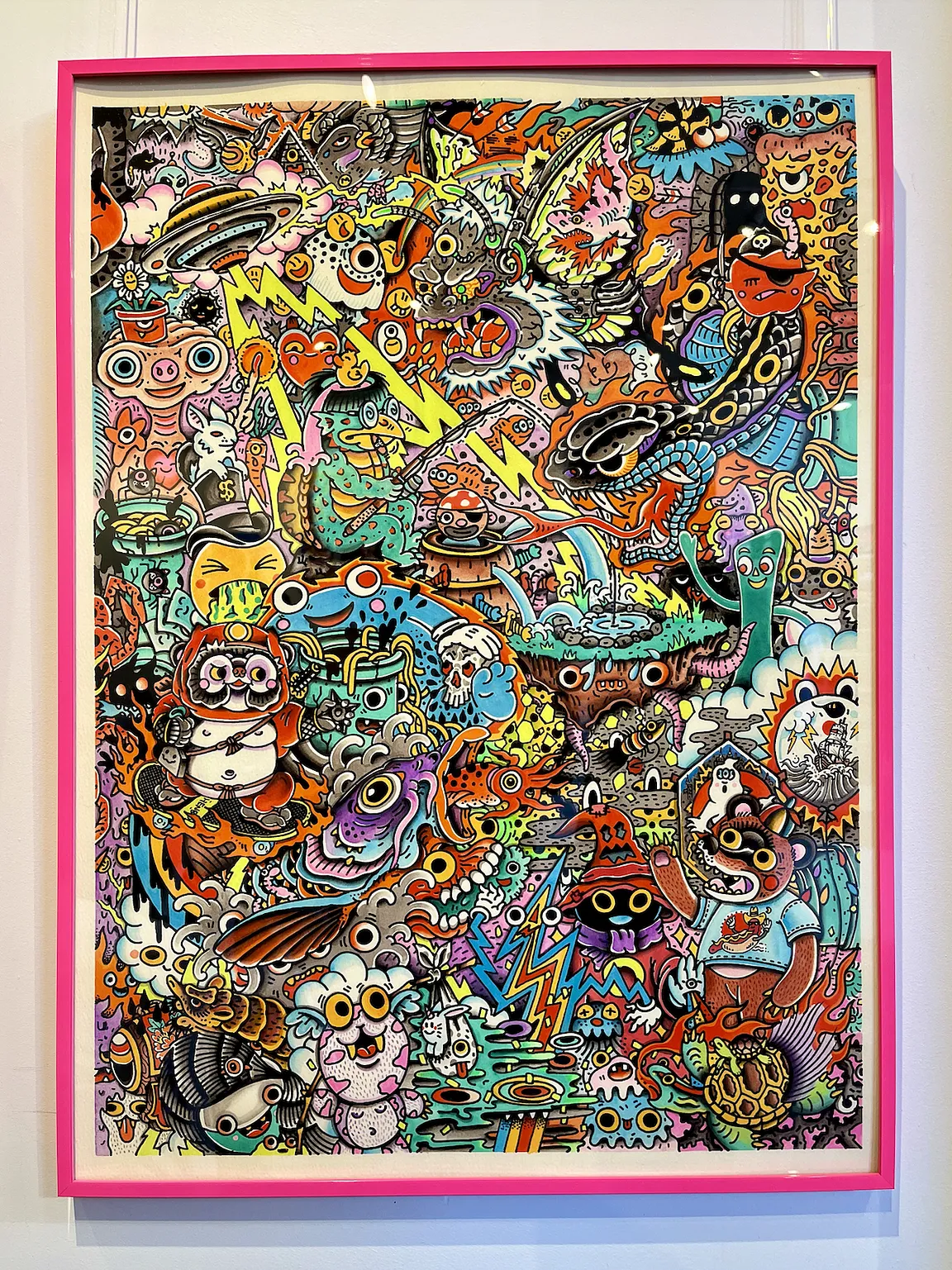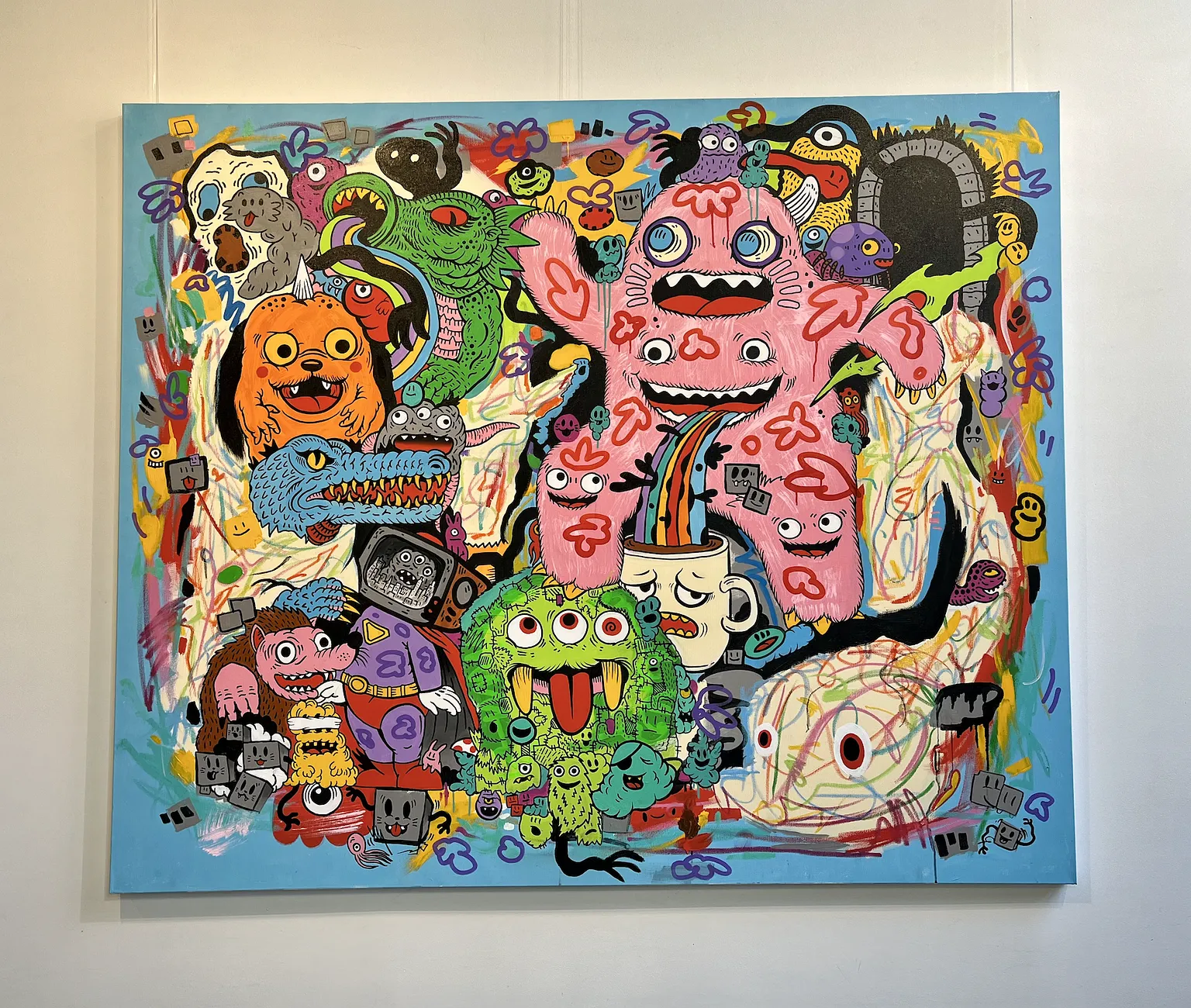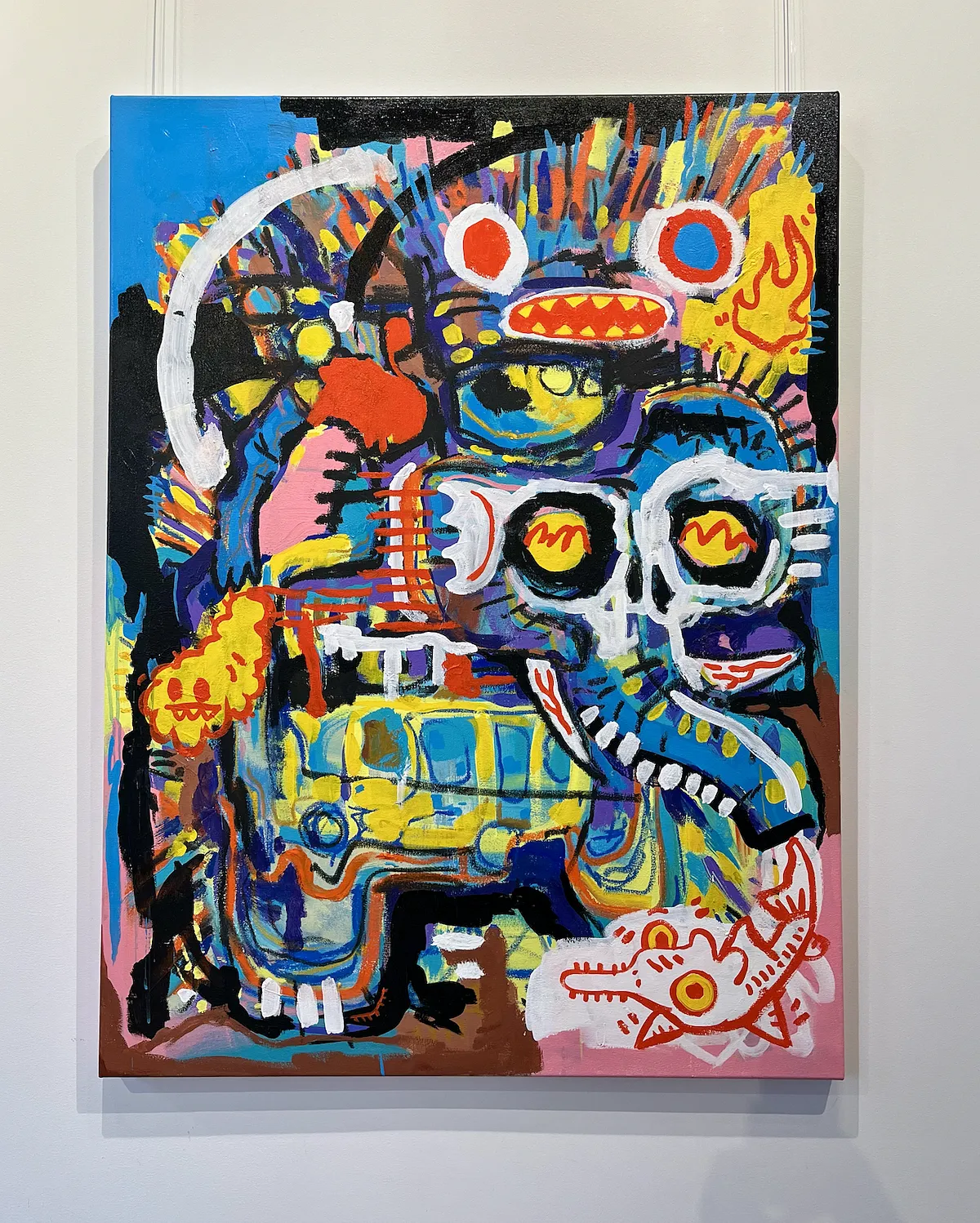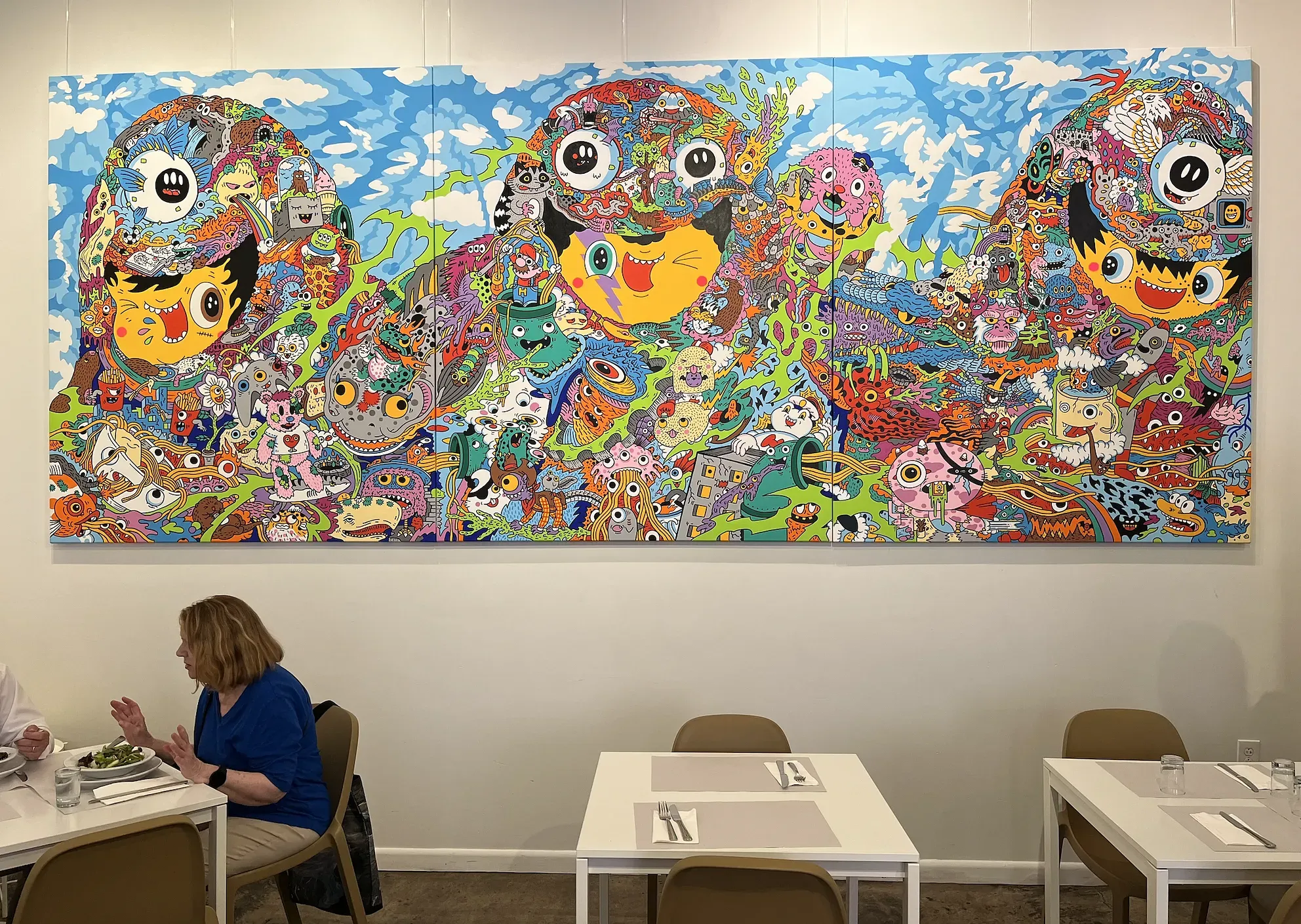Henbo Henning: A Closer Look
FRIEDAcommunity
320 Walnut St.
Philadelphia
July 2, 2024
Inside a European-style “safe space” cafe, as poised middle-aged couplets dined on their petit déjeuner, I was having a different brunch experience: Staring into the blood shot eyes of my childhood friend Gumby, who was hanging from the restaurant ceiling.
Gumby, whom Wikipedia describes best as a “blocky green humanoid made of clay,” is one of seemingly hundreds of fictional characters stuffed into a series of psychedelic paintings and illustrations by artist Henbo Henning that are currently on display at Frieda’s.
Henning’s expansive and hyper-involved art works, mostly inspired by traditional and Japanese tattooing, are a foil to Frieda itself, which claims to be a “blank canvas” of a space rather than a straightforward coffee shop or brunch stop.
In addition to meals and local artisanal goods, the establishment offers regular creative workshops, film screenings and artist talks and exhibits. It’s one of those places that eschew wifi in hopes of getting patrons speaking to other people instead of surfing the web.
Henning’s trippy triptychs and sprawling canvases are set to lord over Frieda’s Scandinavian-inspired white walls through Sept. 15. Though the show is up for mere months, the bold outlining and intense shading featured in most of Henning’s work suggest that Frieda is flexing the fact that it’s all tatted up and ready to remain a Philly fixture.

Brimming with color — think orange flame borders, neon yellow lightning zaps, and peach pink detailing — the pieces appear primarily, though not exclusively, interested in Japanese iconography. There’s E.T., there’s anthropomorphic pizza, and there’s Gumby. But there’s also plenty of Yokai, or Japanese folkloric spirits, incorporated into the forefront.
For example, Henning depicts a kappa at least once. That’s a legendary aquatic reptilian typically depicted with tortoise shells or fish scales as well as hollow scalps that house water, which, if spilled, reportedly cause the creatures to lose their supernatural powers.
In Henning’s world, the kappa is seen with bubblegum water falling out of his torn toupée, a rubber duck floating contentedly in the remaining brain drain while the beaked, turtle-looking being smokes a cigar and casts his fishing line into the surrounding collage of cartoon faces and three-eyed fish — the latter of which is, of course, an homage to The Simpsons, which I can only assume is everyone’s favorite T.V. show, too.
My first instinct upon seeing pop art so similarly overstimulating and overwhelming is to shrug it off as mushroom-induced, Grateful Dead rip-off adjacent meaninglessness. Just because something is intricate doesn’t mean it’s interesting.
But while Henning’s pieces arguably showcase stylistic talent over originality, they also read as a curated and historic mash-up of the doodles, identities, and cultures that have inspired him as an artist. It might be interpreted as an attempt to taxonomize and celebrate the characters that made Henning himself.
It’s a compelling tribute to the sometimes symbolic, sometimes starkly random process of world building and character development. When my eyes first locked with Gumby’s that afternoon, I was instantly compelled to scan my brain for any possible details of the universe occupied by the iconic claymation kid. I, naturally, ended up on Wikipedia — and found out that Gumby’s life was far richer than I ever could have recalled or imagined. Not only is his his sidekick an anthropomorphic pony, but Wikipedia tells me that other characters on the show include “Prickle, a yellow fire-breathing dinosaur who sometimes styles himself as a detective with pipe and deerstalker hat like Sherlock Holmes; Goo, a flying blue shapeshifting mermaid who spits blue goo balls; Gumbo and Gumba, Gumby’s parents; and Nopey, Gumby’s dog whose entire vocabulary is the word “nope”. The 1988 syndicated series added Gumby’s sister Minga, mastodon friend Denali, and chicken friend Tilly.”
So, even if I don’t remember it, a mastodon named Denali and a dog addicted to saying “no” must have informed my childhood, and ultimately adult, subconscious. And I have Henning to thank for spawning that realization.
Anyway, I got a kick out of watching Frieda’s customer base of the day — described aptly in this Broad Street Review article as “yuccies (young urban creatives), moms with toddlers, and retirees” — eat French omelets and sip lattes while surrounded by monsters swallowing other monsters: A Japanese Koi consuming a squid; misshapen blobs puking out spaghetti and eyeballs; a fish boiling alive inside a crazed mug of water missing all but four teeth and puffing a pipe.

One particular trilogy of canvases (pictured at the top of this article) shows three seemingly related mammoths made up of many smaller, highly imaginative creatures, all anthropomorphized easily thanks to the simple addition of one dimensional googley eyes. It’s like a visual foray into the phenomenon of face pareidolia. Or a reminder that there’s soul in everything we perceive. Or, to put it another way, that we’re always making characters up in our minds, and while that might be nothing more than mere projection, it’s also symbolic of how all our social influences and environments intersect to define us as individuals, and how as we connect by association as individuals, we become increasingly aware of a greater psychological and spiritual whole that exists above and beyond ourselves.
Run-on sentences mean we’re teetering too far into trippy territory — though I suppose that’s what Henning inspires.
While I rudely stared over the heads of diners to study the highly detailed images, Frieda Co-Owner Thomas Steinborn noticed my interest in the art and kindly offered me literature about the exhibit.
In addition to handing me a card-sized autobiography of Henning — which revealed that the England-born and New York-based illustrator, animator and tattoo artist has had a life-long “affinity for strange creatures: octopuses, polliwogs, axolotls” — Steinborn filled me in on how Frieda’s came to be.
Founded in 2015 by Steinborn, who’s originally from Germany, and David Wong, a Tahiti native, Freida’s has always aimed to develop an environment where disagreeing is actually encouraged amid an otherwise increasingly polarizing political climate. Art, Steinborn said, is an invitation to entertain true dialogue. And the value of disagreement is often overlooked — just like artists and their work are too often taken for granted, he argued further.

He gave an example. The previous art show displayed on Frieda’s wall was a collection of photographs of naked women over 65 taken by American photographer Nancy Hellebrand. During a talk given by Hellebrand at Frieda’s, several expressed support for the project: “I’d never even seen my mother or her mother naked,” audience members reflected. Others, Steinborn said, were just grateful to see images of real people showcased and normalized in a public place — while a few were disgruntled that that public place had to be around the table where they were eating.
However, Steinborn said that at the end of the night, multiple individuals who had heartily critiqued the exhibit changed their mind upon talking it out with their neighbors and the artist herself. So much so that they volunteered to model nude for Hellebrand themselves.
That, Steinborn concluded, is the essence of how Frieda’s started growing when he and Wong first moved to Philly without knowing anyone a decade back. And it’s how they want its community to continue developing: “One contact at a time.”
It’s not always about pushing boundaries, either, he noted. The food menu “is very simple, very basic, but very special.” Virtually everything is made from scratch — even just a slice of toast and jam, he offered as an example, comes from loaves of bread and jars of fruit preserve made in-house.
Henning’s exhibit isn’t particularly controversial either, but it’s an organic and generative continuation of Frieda’s purported efforts to thicken their customers’ and community’s skin without losing sensitivity. After stripping down the septuagenarian nudes, it only made sense that Frieda would turn to a tattoo artist to talk about the cultural images so many of us opt to transpose onto our own bodies.
Henning himself is slated to lead a drawing class at Frieda’s this month. I’ll be there. Not only to connect with and learn from another East Coast artist — but to demand that he acquaint me with the many characters currently lining Frieda’s walls who I didn’t recognize this afternoon. Even if I can’t shake their hands, I’d like to learn their stories.
NEXT:
Henning’s artwork remains on display at Frieda’s through September 15. He will lead an art workshop inside the space on July 20 — find out more here. And if you’ve got between $2,500 and $30,000 to throw around, you could buy one of Henning’s original art pieces. I personally want to pay off my student loans first.






